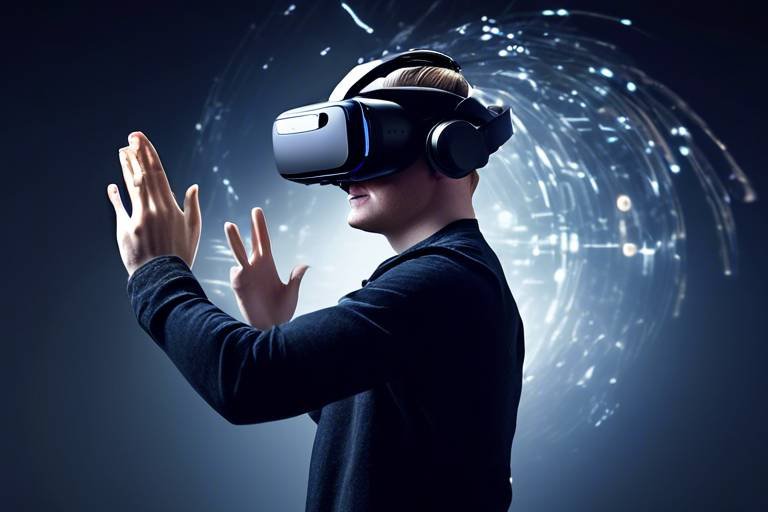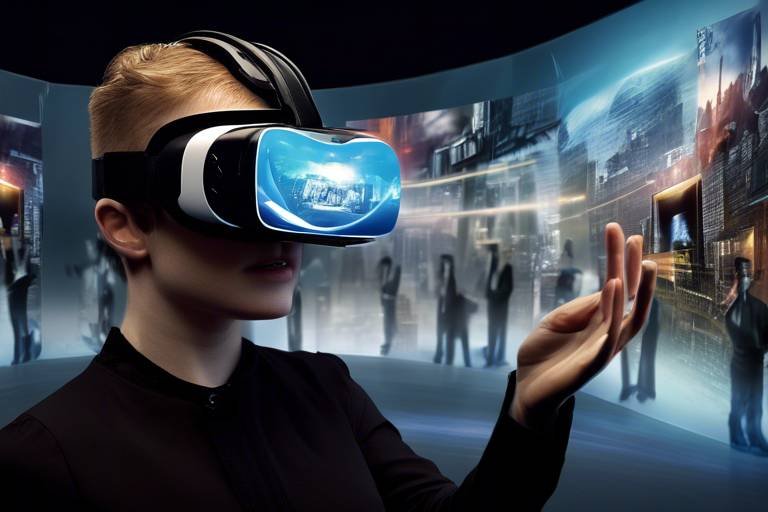Wearable Tech in Sports: A New Era of Performance Analysis
Welcome to the future of sports! Wearable technology is not just a buzzword; it's a game changer that has transformed how athletes train, compete, and recover. Imagine having a personal coach, a nutritionist, and a medical team all packed into a small device you can wear on your wrist or head. That's the power of wearable tech in sports today. From tracking heart rates to analyzing biomechanical movements, these devices are revolutionizing performance analysis and pushing the boundaries of human potential.
As we dive deeper into this new era, you'll discover how wearable technology is not only enhancing individual performance but also reshaping team dynamics and fan engagement. The integration of real-time data collection and analysis into training regimes allows athletes to make informed decisions that can lead to improved outcomes. It's like having a secret weapon that gives athletes the edge they need to outperform their competition.
But what exactly does this technology entail? Wearable devices can range from smartwatches and fitness trackers to advanced biometric sensors and smart clothing. Each of these tools serves a unique purpose, yet they all share a common goal: to optimize athletic performance and minimize the risk of injury. As we explore the various types of wearable tech available, it's essential to understand their significance in the world of sports performance analysis.
In this article, we will delve into the myriad benefits that wearable technology offers athletes, including the ability to monitor performance in real-time, create personalized training programs, and develop effective recovery strategies. Furthermore, we'll examine how this technology is being utilized in team sports to enhance collaboration and strategy, ultimately leading to better overall performance.
As we progress, we'll also look at how wearable tech is transforming the fan experience, providing interactive and immersive opportunities for spectators to engage with their favorite sports. With advancements like augmented reality, the lines between athletes and fans are blurring, creating a more connected sports community.
Finally, we'll gaze into the future, exploring the emerging trends and innovations that promise to shape the next generation of performance analysis tools. The world of wearable technology is evolving rapidly, and staying ahead of the curve is essential for athletes, coaches, and fans alike.
- What types of wearable technology are commonly used in sports? Wearable technology includes devices such as fitness trackers, smartwatches, GPS monitors, heart rate monitors, and smart clothing.
- How does wearable tech improve athlete performance? It provides real-time data that helps athletes monitor their performance, adjust training regimens, and prevent injuries.
- Can wearable tech be used in team sports? Yes, teams utilize wearable technology to track player performance, enhance communication, and develop strategies based on data analysis.
- What role does augmented reality play in fan engagement? Augmented reality creates immersive experiences for fans, allowing them to interact with live data and enhance their viewing experience during events.
- What are the future trends in wearable technology for sports? Future trends include advancements in biometric sensors, AI integration for personalized training, and enhanced data analytics capabilities.

Introduction to Wearable Technology
Wearable technology has taken the sports world by storm, fundamentally altering how athletes train, compete, and recover. Imagine a world where your wristband not only tracks your heart rate but also offers insights into your hydration levels, sleep patterns, and even your performance metrics in real time. This is not science fiction; it's the reality of wearable tech today. These devices are designed to be worn on the body, seamlessly integrating into an athlete's routine while providing a wealth of data that can be analyzed for performance enhancement.
There are various types of wearable devices available, each serving a unique purpose in the realm of sports performance analysis. From smartwatches and fitness trackers to specialized sensors embedded in clothing, these devices are equipped with advanced technologies such as GPS, accelerometers, and heart rate monitors. They collect an array of data points that can be invaluable for athletes and coaches alike. For instance, a smartwatch may track distance and speed during a run, while a smart jersey can monitor muscle strain and fatigue levels.
But why is this technology so significant? The answer lies in the ability to transform raw data into actionable insights. In the past, athletes relied heavily on subjective assessments of their performance. Now, with data at their fingertips, they can make informed decisions about their training regimens and recovery protocols. This shift towards a data-driven approach is not just a trend; it's a new paradigm in sports science.
As we delve deeper into the world of wearable technology, it's essential to recognize how these innovations are not only enhancing individual athlete performance but also reshaping the entire landscape of sports. From injury prevention strategies to tailored training programs, the benefits are vast and varied. Moreover, the implications extend beyond the athletes themselves, impacting coaches, teams, and even the fans who follow them.
In the following sections, we will explore the myriad benefits of wearable tech for athletes, the impact on team sports, and how it is revolutionizing fan engagement. The future of sports is here, and it’s being powered by technology that fits right on your wrist.

Benefits of Wearable Tech for Athletes
Wearable technology has emerged as a game-changer for athletes, offering a treasure trove of benefits that can significantly enhance their performance. Imagine having a personal coach that never sleeps—this is what wearable tech brings to the table. From real-time data collection to personalized training programs, these devices are designed to optimize every aspect of an athlete's routine. The impact is profound, allowing athletes to push their limits while minimizing risks.
One of the standout advantages of wearable tech is its ability to provide real-time data collection. Athletes can now monitor vital statistics such as heart rate, speed, distance, and even sleep patterns during training sessions. This immediate feedback loop is crucial; it enables athletes to make quick adjustments to their training plans. For instance, if an athlete notices their heart rate spiking unexpectedly, they can modify their intensity on the fly. This level of responsiveness fosters a more effective training environment.
Furthermore, wearable devices can help in crafting personalized training programs. Each athlete is unique, with different strengths, weaknesses, and goals. By analyzing the data collected, coaches and trainers can tailor programs that cater specifically to the individual athlete's needs. This personalized approach ensures that every session is productive, maximizing the athlete's potential. For example, a runner might receive a training schedule that focuses on improving their sprint times based on data from previous runs.
Another critical benefit of wearable tech is its role in improving recovery strategies. Recovery is just as important as training, and wearable devices can monitor an athlete's recovery status by tracking metrics such as muscle fatigue and heart rate variability. This information helps athletes understand when their bodies are ready to train again, reducing the risk of overtraining. A well-timed recovery can mean the difference between peak performance and injury, making this aspect of wearables invaluable.
Real-time performance monitoring is a cornerstone of wearable technology's impact on athletics. Imagine being able to see your performance metrics instantly, like a dashboard on a race car. This immediate access to data allows athletes to make informed decisions during both training sessions and competitions. For example, a cyclist can adjust their pace based on real-time power output, ensuring they conserve energy for a strong finish. This kind of dynamic adjustment is impossible without the insights provided by wearable tech.
With the vast amounts of data collected, athletes can make data-driven training adjustments that lead to optimized outcomes. Coaches can analyze trends over time, identifying what works and what doesn’t. This leads to more efficient training regimens, as athletes can focus on areas that need improvement. For instance, a swimmer might discover that their stroke rate impacts their speed more than their stroke length, prompting a shift in focus during practice. The ability to pivot based on solid data is a significant advantage in the competitive world of sports.
Injury prevention is another area where wearable technology shines. By continuously monitoring workload and biomechanics, these devices can alert athletes to potential risk factors before they lead to serious injuries. For example, if an athlete is consistently exceeding their normal workload, the device can send alerts to reduce intensity. This proactive approach not only helps athletes stay in the game longer but also saves teams and organizations significant costs associated with injuries. The peace of mind that comes from knowing you are taking steps to prevent injury is invaluable.
In team sports, wearable tech enhances collaboration and strategy. Teams can utilize data from all players to improve overall performance and communication. For instance, a soccer team can analyze player movements and fatigue levels to make strategic substitutions during a match. This data-driven approach creates a more cohesive team strategy, ensuring that each player is utilized to their full potential.
In conclusion, the benefits of wearable technology for athletes are profound and multifaceted. From real-time monitoring to personalized training and injury prevention, these devices are transforming how athletes train and compete. As technology continues to evolve, we can only expect these benefits to expand, pushing the boundaries of what athletes can achieve.
- What types of wearable technology are available for athletes?
There are various types of wearable tech, including fitness trackers, smartwatches, heart rate monitors, and GPS devices, each designed to track different performance metrics. - How does wearable tech help in injury prevention?
Wearable devices monitor workload and biomechanics, alerting athletes to potential risks before they lead to injuries. - Can wearable tech be used in team sports?
Absolutely! Teams use wearable technology to analyze player performance data, which helps improve overall strategy and communication. - Is real-time data collection beneficial for all athletes?
Yes, real-time data collection helps athletes of all levels make informed decisions during training and competitions, enhancing their performance.

Real-Time Performance Monitoring
In the fast-paced world of sports, every second counts. has emerged as a game-changer, allowing athletes to track their metrics and make instant adjustments during training and competitions. Imagine being able to see your heart rate, speed, and even muscle exertion levels on your wrist while you're in the middle of a sprint. This technology not only enhances the athlete's performance but also provides a wealth of data that can be analyzed to improve future training sessions.
With wearable devices like smartwatches, heart rate monitors, and GPS trackers, athletes can gather crucial information about their physical state. Here’s how real-time monitoring can elevate performance:
- Immediate Feedback: Athletes can receive instantaneous insights into their performance, allowing them to adjust their techniques on the fly. For instance, a runner can modify their pace based on real-time heart rate data to avoid fatigue.
- Enhanced Decision-Making: Coaches and trainers can access live data feeds during games or training sessions, enabling them to make informed decisions about substitutions, strategies, and training intensity.
- Motivation Boost: Seeing real-time statistics can motivate athletes to push their limits. When they can visualize their performance metrics, it’s like having a personal cheerleader encouraging them to go faster, jump higher, and train harder.
Moreover, real-time performance monitoring can be pivotal in competitive environments. Consider a basketball player who can track their shooting accuracy during practice. If they notice a dip in their shooting percentage, they can immediately adjust their shooting form or technique, rather than waiting for a post-practice review. This immediate feedback loop creates a dynamic training environment where athletes can continuously improve.
Another fascinating aspect is the integration of these monitoring systems with mobile apps. Athletes can sync their wearable devices to apps that analyze their data, offering insights into trends and patterns over time. This capability allows for a more comprehensive understanding of performance, leading to tailored training programs that address specific weaknesses. For example, if data shows that an athlete consistently struggles with endurance in the second half of a game, their training can be adjusted to focus on stamina-building exercises.
As technology continues to evolve, the potential for real-time performance monitoring in sports is limitless. Athletes are no longer just relying on their instincts; they have a treasure trove of data at their fingertips. This shift is akin to having a coach who never sleeps, always ready to provide feedback and guidance. In a world where milliseconds can determine the outcome of a competition, real-time performance monitoring is not just a luxury—it's a necessity.

Data-Driven Training Adjustments
In the fast-paced world of sports, where every second counts and every move can make or break a game, have emerged as a game-changer for athletes. Imagine being able to tweak your training regimen based on real-time feedback rather than guesswork. This is the magic of wearable technology. With devices that monitor everything from heart rate to movement patterns, athletes can make informed decisions that enhance their performance significantly.
Let's break it down: when an athlete wears a device that tracks their performance metrics during training, they gain access to a treasure trove of information. For example, a runner might discover that their heart rate spikes at a certain pace, indicating that they need to adjust their speed or endurance training. Similarly, a football player might find that their sprinting mechanics lead to fatigue much earlier than expected, prompting a reassessment of their training intensity. This immediate access to data allows for swift adjustments that can lead to improved performance and reduced risk of injury.
Moreover, the integration of data analytics into training programs facilitates a more personalized approach. Coaches and athletes can analyze performance trends over time, identifying strengths and weaknesses that may not be immediately apparent. For instance, if a basketball player consistently struggles with shooting accuracy after a specific number of shots, this insight can lead to targeted drills that focus on stamina and technique. This tailored approach not only enhances training efficiency but also keeps athletes motivated, as they see tangible improvements in their performance.
To illustrate this point further, consider the following table that outlines how data-driven adjustments can impact different aspects of training:
| Aspect of Training | Data Insights | Training Adjustments |
|---|---|---|
| Endurance | Heart rate variability during long runs | Incorporate interval training to build stamina |
| Strength | Muscle fatigue levels during weight lifting | Adjust weight and repetitions for optimal recovery |
| Technique | Biomechanical analysis of movement patterns | Focus on form correction and specific skill drills |
As we can see, the power of data-driven training adjustments lies in its ability to refine and optimize every aspect of an athlete's regimen. This not only leads to better performance but also fosters a deeper understanding of one's body and capabilities. In a world where technology continues to evolve, athletes who leverage these insights are not just training harder; they are training smarter.
- What types of wearable technology are best for athletes? There are various devices including heart rate monitors, GPS trackers, and motion sensors that cater to different sports and training needs.
- How does data analysis improve training? Data analysis helps identify patterns and trends, allowing athletes to make informed adjustments to their training programs for optimal performance.
- Can wearable tech prevent injuries? Yes, by monitoring workload and biomechanics, wearable tech can help identify risk factors and inform preventative strategies.
- Are data-driven adjustments suitable for all athletes? Absolutely! Athletes at any level can benefit from personalized training adjustments based on data insights.

Injury Prevention Strategies
Injuries are an athlete's worst nightmare, and that's where wearable technology steps in like a superhero ready to save the day! These innovative devices are not just fancy gadgets; they are essential tools that help athletes monitor their body mechanics and workloads in real-time. By keeping a close eye on how an athlete moves and the stresses placed on their body, wearable tech can provide invaluable insights that lead to effective injury prevention strategies.
One of the key features of wearable technology is its ability to track various metrics such as heart rate, speed, distance, and even muscle strain. For instance, devices like smartwatches and fitness trackers can monitor an athlete's heart rate variability (HRV), which is a significant indicator of recovery and overall fitness. If an athlete's HRV drops below a certain threshold, it could signal that they are overtraining or at risk of injury. This data allows coaches and athletes to adjust training loads accordingly, ensuring they aren't pushing their bodies too hard.
Moreover, wearable devices often include motion sensors that can analyze biomechanics. By examining how an athlete runs, jumps, or pivots, coaches can identify improper techniques that may lead to injuries. For example, an athlete might have a tendency to land awkwardly after a jump, which could increase the risk of ankle sprains. With this information, corrective measures can be taken, such as modifying training techniques or incorporating specific strength exercises to improve stability.
Another crucial aspect of injury prevention is the ability to monitor workload. Wearable technology can track the intensity and duration of training sessions, providing insights into whether an athlete is training too hard or too lightly. This data can be represented in a workload chart, which helps coaches and athletes visualize training loads over time. Here’s a simple example:
| Week | Training Hours | Injury Risk Level |
|---|---|---|
| 1 | 10 | Low |
| 2 | 15 | Moderate |
| 3 | 20 | High |
In this table, we can see how increasing training hours can correlate with rising injury risk levels. By regularly analyzing this data, athletes can find the sweet spot where they are training effectively without tipping into the danger zone of overuse injuries.
Furthermore, wearable technology can also facilitate communication between athletes and medical staff. For instance, if an athlete begins to experience pain or discomfort, they can quickly share their real-time data with a physiotherapist who can assess the situation remotely. This not only speeds up the response time but also allows for more personalized care tailored to the athlete's specific needs.
In conclusion, the integration of wearable technology into sports is a game-changer for injury prevention. By providing real-time data on biomechanics, workload, and recovery, these devices empower athletes and coaches to make informed decisions that enhance performance while minimizing the risk of injury. It's like having a personal coach and a medical team right on your wrist, ready to guide you toward safer and more effective training!

Impact on Team Sports
The integration of wearable technology in team sports has been nothing short of revolutionary. Imagine a world where coaches and players can access real-time data that not only enhances performance but also fosters better collaboration and strategic decision-making. With devices like smart jerseys, GPS trackers, and heart rate monitors, teams are now able to analyze player performance on a granular level, leading to a more cohesive unit on the field.
One of the most significant impacts of wearable tech is the ability to collect and analyze data during practices and games. Coaches can now monitor vital statistics such as speed, distance covered, and even fatigue levels. This data enables them to make informed decisions about player substitutions and training adjustments. For example, if a player’s heart rate spikes unusually during a match, it might indicate that they are overexerting themselves, prompting the coach to pull them out for a breather. This proactive approach not only helps in maintaining optimal performance but also minimizes the risk of injuries.
Moreover, wearable technology fosters a culture of accountability among players. When athletes know that their performance is being monitored, they are more likely to push their limits and strive for improvement. This shift in mindset can lead to enhanced teamwork as players become more aware of their contributions to the team's overall performance. It’s like having a personal coach on your wrist, constantly motivating you to give your best. In essence, wearable tech turns individual efforts into collective successes.
Furthermore, data collected from these devices can be used to tailor training programs to meet the specific needs of each athlete. Coaches can identify strengths and weaknesses and create personalized training regimens that optimize each player’s potential. This customization is akin to having a bespoke suit tailored just for you; it fits perfectly and enhances your best features. Teams that leverage this technology are often the ones that dominate the field, as they can adapt and evolve based on the insights gained from performance data.
Another fascinating aspect of wearable technology in team sports is its role in injury prevention. By continuously monitoring biomechanics and workload, teams can identify patterns that may lead to injuries. For instance, if data shows that a player is consistently landing awkwardly after jumps, coaches can intervene with corrective training. This proactive strategy is akin to having a safety net that catches potential issues before they escalate into serious problems.
In summary, the impact of wearable technology on team sports is profound. It enhances performance analysis, encourages accountability, personalizes training, and plays a pivotal role in injury prevention. As teams continue to embrace these innovations, we can expect to see an evolution in how sports are played and coached. The future looks bright for athletes who are willing to adapt and leverage the power of technology in their quest for excellence.

Fan Engagement and Experience
In today's fast-paced world, where technology intertwines with every aspect of our lives, wearable technology is not just transforming athletes' performance but also revolutionizing the way fans engage with their favorite sports. Imagine attending a game and having access to real-time statistics, player biometrics, and even interactive experiences that make you feel like you're part of the action. This is no longer a dream; it’s a reality that wearable tech is making possible.
Wearable devices, such as smartwatches and fitness trackers, have become essential tools for fans. They allow spectators to monitor their own health metrics while enjoying the thrill of live sports. For instance, fans can track their heart rate, calories burned, and even their hydration levels during a game. This personal data collection enhances the overall experience, making it not just about watching the game but also about participating in a holistic sports experience.
Moreover, the integration of augmented reality (AR) into wearable technology is creating immersive experiences that take fan engagement to the next level. Picture this: you’re at a stadium, and by simply looking through your AR glasses or using your smartphone, you can see player stats, historical data, and even live updates projected right onto the field. This kind of interaction makes every game feel like a unique event, where fans are not just passive observers but active participants in the unfolding drama.
Furthermore, teams are leveraging data collected from wearable devices to enhance fan experience. By analyzing how fans interact with the game, teams can tailor their marketing strategies, improve stadium facilities, and create personalized experiences. For example, if data shows that fans are particularly interested in certain players or stats, teams can focus their social media campaigns and in-stadium promotions around those interests. This creates a deeper connection between the fans and the team, fostering loyalty and engagement.
To illustrate the impact of wearable technology on fan engagement, consider the following table:
| Wearable Technology | Fan Engagement Benefits |
|---|---|
| Smartwatches | Real-time stats, health tracking |
| AR Glasses | Immersive experiences, enhanced viewing |
| Fitness Trackers | Personal health metrics during events |
| Mobile Apps | Interactive games, fan polls, rewards |
In addition to these technologies, the rise of mobile apps that sync with wearables has opened up new avenues for fan interaction. Fans can participate in live polls, trivia games, and even rewards programs that encourage them to engage more deeply with their teams. Imagine earning points for attending games, which can then be redeemed for merchandise or exclusive experiences. This gamification of fan engagement is a win-win for both teams and their supporters.
In conclusion, wearable technology is not just a tool for athletes; it's a bridge connecting fans to the sports they love. By enhancing interactivity, providing real-time data, and creating immersive experiences, wearable tech is redefining the spectator experience. As technology continues to evolve, we can only imagine the exciting innovations that lie ahead, making every game day an unforgettable adventure for fans.
- What types of wearable technology are commonly used by fans? Fans often use smartwatches, fitness trackers, and AR glasses to enhance their game-day experience.
- How does wearable tech improve fan engagement? It provides real-time statistics, interactive experiences, and personalized health metrics, making fans feel more connected to the game.
- Will wearable technology continue to evolve in sports? Absolutely! As technology advances, we can expect even more innovative ways to engage fans and enhance their experience.

Augmented Reality Integration
Augmented Reality (AR) is not just a buzzword; it’s a game-changer in the world of sports, especially when integrated with wearable technology. Imagine being in the stands, watching your favorite team, and having real-time stats, player bios, and even play-by-play analysis projected right before your eyes. This isn’t science fiction; it’s the reality that AR brings to sports. By merging digital information with the physical world, AR enhances the spectator experience, making it more interactive and engaging than ever before.
One of the most exciting aspects of AR integration is its ability to provide immersive experiences. For instance, fans can use their smartphones or AR glasses to see a 3D replay of a crucial play from different angles, right on the field. This level of engagement not only keeps fans glued to their seats but also deepens their understanding of the game. Moreover, AR can offer contextual information, such as player statistics or historical data, enriching the viewing experience and making it more informative.
But it’s not just about the fans; AR is also revolutionizing how athletes train. Coaches can use AR to visualize tactics on the field, allowing players to see their positions and movements in a simulated environment. This visualization technique can lead to better strategic planning and execution during real games. For instance, imagine a soccer coach using AR to demonstrate a new formation, allowing players to see exactly where they need to be at any given moment. This kind of technology bridges the gap between theory and practice, making training sessions more effective.
The integration of AR in sports is still in its infancy, but the potential is enormous. Companies are constantly innovating, creating applications that allow fans to interact with their favorite sports in unprecedented ways. Here are some of the key benefits of AR integration in sports:
- Enhanced Fan Experience: Fans can engage with the game through interactive content, making every match feel like an event.
- Real-Time Information: Instant stats and analytics keep fans informed and entertained.
- Improved Training Sessions: Athletes can visualize plays and strategies, leading to better on-field performance.
As we look to the future, the possibilities for AR in sports are limitless. With advancements in technology, we can expect to see even more sophisticated applications that will further blur the lines between the virtual and real worlds. Whether it’s through enhanced viewing experiences or innovative training methods, AR is set to redefine how we perceive and engage with sports.
In conclusion, the integration of augmented reality into sports is paving the way for a more interactive and engaging experience for both athletes and fans. As technology continues to evolve, we can only imagine the exciting developments that lie ahead in this arena.

Future Trends in Wearable Technology
The future of wearable technology in sports is not just bright; it's practically glowing with potential! As we look ahead, several exciting trends are set to redefine how athletes train, perform, and engage with their fans. Imagine a world where your fitness tracker doesn’t just count steps but also predicts your performance in real-time. This is not science fiction; it's the direction we’re heading. Wearable devices are evolving, becoming smarter, more integrated, and increasingly essential for both athletes and fans alike.
One of the most promising trends is the integration of artificial intelligence (AI) with wearable technology. AI can analyze vast amounts of data collected from these devices, providing athletes with insights that were previously unimaginable. For instance, AI-driven wearables can assess an athlete's biomechanics and suggest adjustments to improve performance and reduce injury risks. This level of personalization in training is akin to having a personal coach available 24/7!
Another key trend is the development of biometric sensors that monitor vital signs such as heart rate, oxygen levels, and even hydration status in real-time. These sensors are becoming more sophisticated, allowing athletes to make immediate adjustments to their training regimens based on their physiological data. Imagine an athlete receiving a notification on their smartwatch that their hydration levels are low during a game—this could significantly impact their performance and prevent fatigue.
Moreover, the rise of augmented reality (AR) is set to create immersive training experiences. Athletes can use AR glasses to visualize their performance metrics while training, providing instant feedback and enhancing their focus. Picture this: a soccer player wearing AR glasses that display their running speed and heart rate as they practice. This not only makes training more engaging but also allows for immediate adjustments to optimize performance.
As we delve deeper into the future, we can also expect to see an increase in wearable tech for injury rehabilitation. Devices designed to monitor recovery processes will become essential, helping athletes track their healing progress and ensure they return to their sport safely. This technology could include smart bands that monitor muscle recovery and suggest when it's safe to resume training.
In addition to these advancements, the concept of interconnectivity among devices will flourish. Imagine all your wearables—fitness trackers, smart shoes, and even smart clothing—communicating with each other, creating a comprehensive ecosystem of data. This interconnectedness will allow for a holistic view of an athlete's performance and health, leading to more informed decisions and better outcomes.
Finally, we can't overlook the impact of fan engagement through wearable tech. As devices become more advanced, fans will have access to real-time statistics and interactive experiences during games. Think about wearing a device that not only tracks your own performance while playing but also allows you to compete against your favorite athletes in real-time. This level of engagement will elevate the spectator experience to new heights, making every game an interactive event.
In summary, the future of wearable technology in sports is brimming with possibilities. From AI integration to enhanced biometric sensors, AR training tools, and improved injury rehabilitation, the landscape is evolving rapidly. As these technologies continue to advance, they will not only enhance athletic performance but also revolutionize the way fans connect with their favorite sports. It's an exhilarating time for both athletes and fans, and the best is yet to come!
- What are wearable technologies? Wearable technologies are electronic devices that can be worn on the body, often used to track fitness, health metrics, and performance data.
- How do wearable devices enhance athlete performance? They provide real-time data, allowing athletes to monitor their performance, make informed training adjustments, and prevent injuries.
- What is the role of AI in wearable tech? AI analyzes the data collected by wearables to provide insights and recommendations for optimizing training and performance.
- Will wearable tech change fan experiences in sports? Absolutely! Wearable tech is set to offer fans interactive experiences and real-time statistics, enhancing their engagement during events.
Frequently Asked Questions
- What types of wearable technology are used in sports?
Wearable technology in sports includes devices like smartwatches, fitness trackers, heart rate monitors, and GPS trackers. These devices collect data on various metrics such as heart rate, speed, distance, and even biomechanics, helping athletes optimize their performance.
- How does wearable technology enhance athlete performance?
Wearable tech enhances athlete performance by providing real-time data that allows for immediate feedback. This feedback helps athletes make on-the-spot adjustments during training and competitions, leading to more effective workouts and better decision-making during events.
- Can wearable technology help prevent injuries?
Absolutely! Wearable technology monitors workload and biomechanics, which can identify potential risk factors for injuries. By analyzing this data, coaches and athletes can adjust training regimens to reduce the likelihood of injuries, ensuring a safer training environment.
- How is wearable technology used in team sports?
In team sports, wearable technology is crucial for enhancing collaboration and strategy. Teams utilize data collected from players to improve overall performance, communication, and game strategies, allowing for a more cohesive team dynamic.
- What role does wearable technology play in fan engagement?
Wearable technology significantly enhances fan engagement by offering interactive experiences and real-time statistics during events. Fans can track player performance and engage with the game in new ways, creating a more immersive experience.
- What is the future of wearable technology in sports?
The future of wearable technology in sports looks promising, with advancements in data analysis, augmented reality, and new device innovations on the horizon. These trends will likely lead to even more sophisticated performance analysis tools and enhanced experiences for both athletes and fans.



















